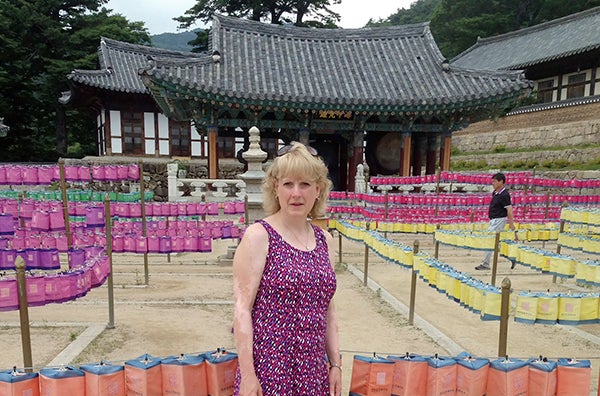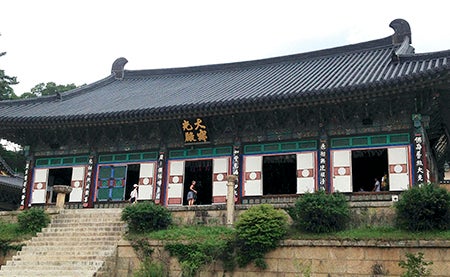Local teacher returns from S. Korea with new ideas for the classroom; Trip about making sure country is discussed, taught
Published 10:42 am Thursday, July 10, 2014

AHS social studies teacher Lisa Sanders recently returned from a trip to South Korea where she learned about the country and its culture. — Photo provided
Lisa Sanders returned from South Korea with many new ideas for teaching social studies.
The Northeast Asian History Foundation sent Sanders on an eight-day trip to the southeastern region of the Korean Peninsula to gain experience with the Korean people and their culture.
“It was an amazing opportunity,” Sanders said. “Our hosts were very, very generous and treated us very well. [They] showed us many aspects of their culture.”
Sanders is the social studies curriculum leader at Austin High School and teaches RCC/Advanced Placement Human Geography, RCC World History, AP U.S. History II and Global Insights.
Although South Korea is not studied much in world history due to years of isolation, Sanders said this trip was about helping to make sure the country is discussed and taught. She said South Koreans are proud of their culture and want to share it with others.
Since Sanders teaches Human Geography, she is excited to be able to use things she learned from South Korea. She is bringing back information about greenhouses, rice fields, Korean food, political territory, industrialization and the Kia car company, population, and size and layout of cities in Urban Development to use in her lessons.

Sanders and her group visited a Buddhist monastery while touring South Korea on their eight-day trip. The trip was designed for educators to learn more about Korean culture. — Photo provided
She loved seeing the old, traditional buildings, as well as the new, modern buildings.
“You have the old and you have the new,” Sanders said.
Firsthand learning
Sanders’s group was made up of 14 teachers from different states in the U.S. who teach the College Board preparatory course AP Human Geography, as well as one cartography expert, and the delegation leader. The trip was paid for by the Northeast Asian History Foundation and supported by the Austin Public Schools.
Sanders’s group visited many places in South Korea, including the Demilitarized Zone/Joint Services Area at the border of North and South Korea, where they could see into North Korea. They also toured Seoul, the capitol of South Korea, and visited a royal palace.
They participated in a one-day conference where some of the U.S. delegates and the Korean delegates shared papers on the territorial disputes that exist between Korea and Japan over the island of Dokdo and the sea located between Korea and Japan, whether it should be referred to as the East Sea or the Sea of Japan.
Other U.S. delegates presented posters they created reflecting surveys conducted of students in regards to what they know about Korea and how they have gained that knowledge. Sanders called it an enlightening day as many of the Korean delegates who presented are involved in organizations and committees that represent the South Korean government and their view of these territorial disputes.
One of the delegates was Dr. Jino Kwak, a researcher at the Northeast Asian History Foundation. He will speak at the National Council for Geographic Education conference in Memphis, Tenn., in August.
The group was able to visit agricultural and industrial sites and learn about the historical and cultural heritage sites representing the Korean Peninsula’s 3,000 year history.
‘Eye opening and informative’
Sanders also experienced traditional scholar tea ceremony. She learned about the traditional clothing and the importance of techniques and hand placement involved in giving and receiving. Members at the tea ceremony are not allowed to pour their own drinks. Out of a sign of respect, someone else will both offer and pour a guest’s drink, and they in turn will do the same.
Sanders said the people she met in South Korea were very humble. When members of her group would thank their hosts, they said they weren’t doing anything special but they enjoyed doing it.
“[There is] beautiful architecture and beautiful paintings,” Sanders said. “And wonderful artifacts throughout the country.”
She experienced the different religions of South Korea, including Buddhism, Christianity and Confucianism. The group spent two days at the Gaya Mountains National Park in the town of Hapcheon, where they were able to visit with monks at the Haeinsa monastery and see the Tripitaka Koreana, a collection of 80,000 writings etched in blocks of wood with Buddhist scriptures and some of the holy books of Buddhism. The pieces are in a special rooms to prevent deterioration and are considered one of the national treasures of South Korea.
Similarly, Sanders saw a Buddhist statue that was protected in the mountains. Preservation tactics are in process, along with keeping the statue air conditioned so it is not destroyed.
As for her favorite part of the trip, Sanders said she could not choose.
“It would be very difficult to pick because it was all equally fantastic and eye opening and informative,” Sanders said.
She and the other group members have plans to reconnect through future conferences. They are also keeping in touch through Facebook.
“[We’ve] built a huge network of colleagues that we can share ideas with,” Sanders said. “We definitely have plans to reconnect, whether with those from the United States or those from Korea.”





